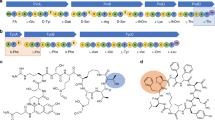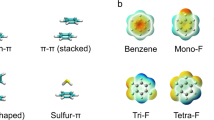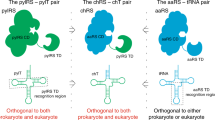Abstract
A single point mutation has been engineered in the tyrosyl-tRNA synthetase that improves its affinity (KM) for its substrate ATP by a factor of 100. In the crystal structure of the tyrosyl tRNA synthetase (of Bacillus stearothermophilus), the side-chain hydroxyl of Thr 51 appears to make a weak hydrogen bond with the AMP moiety of the substrate intermediate, tyrosyl adenylate. In the absence of substrate, however, the hydroxyl group should make a strong hydrogen bond with water which would favour dissociation of the enzyme–substrate complex. We have used oligodeoxynucleotide-directed mutagenesis to construct two point mutants at this site: one to remove the hydroxyl group (Thr 51 → Ala 51) and the other, in addition, to distort the local polypeptide backbone (Thr 51 → Pro 51). We report here that both mutants have increased activity (kcat/KM for ATP) but one mutant (Pro 51) shows a massive 25-fold increase due mainly to a lowered KM for ATP. This demonstrates dramatically the potential of in vitro mutagenesis for improving the affinity of an enzyme for its substrate.
This is a preview of subscription content, access via your institution
Access options
Similar content being viewed by others
References
Hall, A. & Knowles, J. R. Nature 264, 803–804 (1976).
Hall, B. G. Genetics 89, 453–465 (1978).
Hall, B. G. & Zuzel, T. Proc. natn. Acad. Sci. U.S.A. 77, 3529–3533 (1980).
Paterson, A. & Clarke, P. H. J. gen. Microbiol. 114 75–85 (1979).
Turberville, C. & Clarke, P. H. FEMS Microbiol. Lett. 10, 87–90 (1981).
Wu, T. T., Lin, E. C. C. & Tanaka, S. J. Bact. 96, 447–456 (1968).
Winter, G., Fersht, A. R., Wilkinson, A. J., Zoller, M. & Smith, M. Nature 299, 756–758 (1982).
Wilkinson, A. J., Fersht, A. R., Blow, D. M. & Winter, G. Biochemistry 22, 3581–3586 (1983).
Monteilhet, C. & Blow, D. M. J. molec. Biol. 122, 407–417 (1978).
Rubin, J. & Blow, D. M. J. Molec. Biol. 145, 489–500 (1981).
Bhat, T. N., Blow, D. M., Brick, P. & Nyborg, J. J. molec. Biol. 158, 699–709 (1982).
Zoller, M. & Smith, M. Nucleic Acids Res. 10, 6487–6500 (1982).
Sanger, F., Nicklen, S. & Coulson, A. R. Proc. natn. Acad. Sci. U.S.A. 74, 5463–5467 (1977).
Biggin, M. D., Gibson, T. J. & Hong, G. F. Proc. natn. Acad. Sci. U.S.A. 80, 3963–3965 (1983).
Winter, G., Koch, G. L. E., Hartley, B. S. & Barker, D. G., Eur. J. Biochem. 132, 383–387 (1983).
Gait, M. J., Matthes, H. W. D., Singh, M., Sproat, B. S. & Titmas, R. C. Nucleic Acids Res. 10, 6243–6254 (1982).
Winter, G. & Fields, S. Nucleic Acids Res. 8, 1965–1974 (1980).
Author information
Authors and Affiliations
Rights and permissions
About this article
Cite this article
Wilkinson, A., Fersht, A., Blow, D. et al. A large increase in enzyme–substrate affinity by protein engineering. Nature 307, 187–188 (1984). https://doi.org/10.1038/307187a0
Received:
Accepted:
Issue Date:
DOI: https://doi.org/10.1038/307187a0
This article is cited by
-
Specific affinity and relative abundance of methanogens in acclimated anaerobic sludge treating low-strength wastewater
Applied Microbiology and Biotechnology (2020)
-
5-Fluorouracil Co-crystals and Their Potential Anti-cancer Activities Calculated by Molecular Docking Studies
Journal of Chemical Crystallography (2016)
-
Protein engineering 20 years on
Nature Reviews Molecular Cell Biology (2002)
-
Biocatalysis made to order
Applied Biochemistry and Biotechnology (1988)
Comments
By submitting a comment you agree to abide by our Terms and Community Guidelines. If you find something abusive or that does not comply with our terms or guidelines please flag it as inappropriate.



